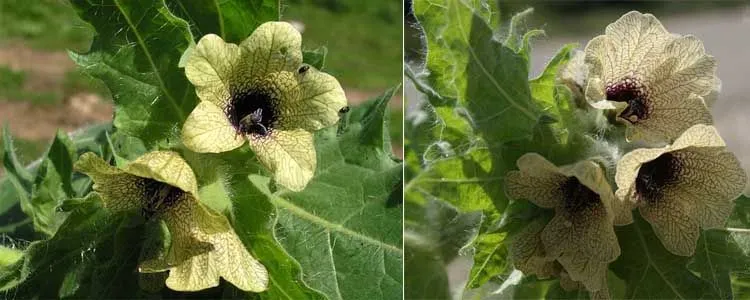
In medicinal plant medicine, we find species that can be potentially toxic, but that a pharmacological expert can obtain interesting substances for modern medicine. This is the case of the black henbane, with compounds as interesting as atropine or hiscoamine.
In this article we want to thoroughly unravel all the possibilities offered by this plant, learn to identify it in the Mediterranean area and, of course, to avoid it, since there is a high degree of toxicity and it must be handled with special caution.
First of all it must be said that the black beleño (Hyoscyamus niger) is considered a poisonous plant due to the high presence of alkaloids (hyoscyamine), which at high doses produce narcotic effects.
Table of Contents
Characteristics of the black henbane
Gender Hyoscyamus it encompasses a group of species containing active compounds of high toxicity. However, learning how to extract them conveniently and how to use them in exact doses, they cover a wide number of drugs of special use in modern medicine.
The extraordinary of the medicinal plants is the great variation of active ingredients, forms and characteristics within each genus and family. For example, Sonalaceae we find edible plants such as tomato, pepper, potato or eggplant, among others.
Black beleño is also known as crazy grass, since in ancient medicine, when used it produced total unconsciousness to the one who took it, and in some cases, outbreaks of euphoria and even death.
At the ornamental level, it is an attractive plant, with large light yellow flowers and leaves with a powerful green color. We can see it growing spontaneously in some areas of Europe (northern Mediterranean), North Africa and Asia.
Any part of the black beleño is venonosa and issues a unpleasant smell that scares away any animal. Its flowering occurs from the month of May, lasting all summer. From them, the seeds are subsequently obtained with the medicinal uses that we will describe later.
Taxonomy
- Family: Solanaceae
- Gender: Hyoscyamus
- Species: Hyoscyamus niger
- Common names: black beleño, abeleño, beleño, hierba de locos, dormidera.
Active ingredients of the plant
The greatest accumulation of active components and pharmacological use are found in seeds and leaves. We find the following compounds in the black beleño:
- Tropane alkaloids: scopolamine (more than 50%), hyoscyamine, hyoscine and atropine.
- Flavonoids: rutósido
In today’s medicine, the alkaloids present in the black henbane have applications very similar to those of the atropine and are used for the preventive treatment of bronchial asthma and to decrease secretion from the respiratory tract during inhalation anesthesia.
Some effects of its active ingredients also offer activity:
- Antiasthmatic.
- Analgesic.
- Sedative of the central nervous system.
Formerly, black henbane was used as an aphrodisiac, and to reduce the effects of epilepsy, insomnia situations, night terrors, asthmatic bronchitis, etc. With the leaves of the plant, infusions were prepared and decoctions.
Another plant with the presence of alkaloids, including atropine, is Solanum dulcamara (devil’s grapes).
Medicinal uses of black henbane
The current medicinal uses that are granted to the black henbane are reserved for professional uses, since it is necessary to control very well the extraction process and the concentration dose of its tropane alkaloids.
Among them, both scoplamine, hyoscinnamine, atropine and hisocin have uses as drugs in modern medicine.
The holy thistle it also accumulates in its fruits some alkaloids, although in much lower concentration than in this plant.
Hyoscyamine
Hyoscyamine is used for symptomatic relief of gast disordersrointestinales, such as peptic ulcers, spasms, irritable bowel syndrome, pancreatitis, colic, and cystitis.
It has also been used to relieve certain heart diseases, some symptoms of Parkinson’s disease, and control of respiratory secretions in palliative care.
Ophthalmological effects
The topical administration Atropine blocks the activation of muscarinic receptors in the ciliary muscles and iris, so it is used to increase pupil dilation in ophthalmological procedures.
It has a persistence of more than 72 hours in the eye and, as it causes blurred vision, it is used applied to the healthy eye to make the lazy work more.
Cardiac effects
The black beleño can increase heart rate and blood conduction speed, so it is commonly used in cases of bradycardia and atrioventricular block.
Effects on the digestive system
Black henbane reduces motility and gastrointestinal discharge and buccal. It is used for the treatment of peptic ulcers, irritable bowel syndrome, and diarrhea.
Respiratory effects
Atropine causes the relaxation of smooth musculature in the airways by inhibition of muscarinic receptors, avoiding bronchoconstriction. It is usually used to decrease excessive secretion in surgical treatments that need general anesthesia
Toxicity of black henbane by hyoscyamine
The alkaloid of greater concetration in the black beleño is the Hyoscyamine which is found in almost all parts of the plant. It is also found, in lesser presence, the alkaloids scopolamine and atropine.
These active ingredients have antimuscarinic action, through a competitive antagonism of acetylcholine receptors. The most common toxicity is that caused by preparing an infusion of beleño for psychoactive purposes.
In some cases there has also been toxicity when its leaves have been confused with those of the chicory plant, since they are quite similar in shape and color.
An excess of doses of the active principles of black henbane caused the following medical picture:
- Digestive and abdominal pain (intestinal hypoperistalsis)
- Nausea, vomiting
- Redness of the skin
- Blurred vision
- Dry mouth and mucous membranes
- Muscle weakness
In more severe cases, hallucinations, stupor, hyperthermia, tachycardia and seizures. The most common treatments start from gastric lavage and the administration of activated charcoal.
